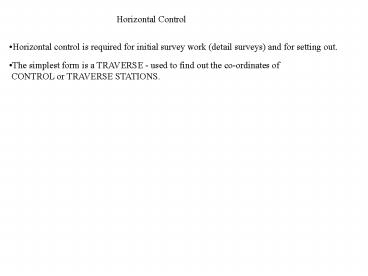Horizontal Control - PowerPoint PPT Presentation
1 / 17
Title:
Horizontal Control
Description:
... control is required for initial survey work (detail surveys) and for setting out. ... 1 in 5000 for most engineering surveys. 1 in 10000 for control for ... – PowerPoint PPT presentation
Number of Views:87
Avg rating:3.0/5.0
Title: Horizontal Control
1
Horizontal Control
- Horizontal control is required for initial survey
work (detail surveys) and for setting out.
- The simplest form is a TRAVERSE - used to find
out the co-ordinates of - CONTROL or TRAVERSE STATIONS.
2
(No Transcript)
3
(No Transcript)
4
a) POLYGON or LOOP TRAVERSE
- There are two types -
b) LINK TRAVERSE
5
- Both types are closed.
a) is obviously closed
b) must start and finish at points whose
co-ordinates are known,
and must also start and finish with angle
observations to other known points.
- Working in the direction A to B to C etc is the
FORWARD DIRECTION
- This gives two possible angles at each station.
LEFT HAND ANGLES
RIGHT HAND ANGLES
6
The L.H.Angles are also the INTERNAL ANGLES
Using a theodolite we can measure all the
internal angles.
S (Internal Angles)
( 2 N - 4 ) 900
The difference between S Measured Angles and S
Internal Angles is the Angular
Misclosure
(or 3)
Maximum Angular Misclosure
(Rule of thumb)
7
Standing at A looking towards F - looking BACK
Hence TAF is known as a BACK BEARING
Standing at A looking towards B - looking
FORWARD
Hence TAB is known as a FORWARD BEARING
BACK BEARING (TAF ) L.H.ANGLE (ltFAB)
NEXT FORWARD BEARING (TAB)
Reminder every line has two bearings
8
12 / 4 3
Traverse Example
Observations, using a Zeiss O15B, 6 Theodolite,
were taken in the field for an anti - clockwise
polygon traverse, A, B, C, D.
Observed Clockwise Horizontal Angle 0
Traverse Station
N
C
B
A
132 15 30
A
126 12 54
B
69 41 18
C
D
31 50 30
D
S (Internal Angles) 360 00 12
Horizontal Distance
Line
S (Internal Angles) should be (2N-4)90 360
00 00
Allowable 3 6 ?N 36
638.57
AB
OK - Therefore distribute error
1576.20
BC
The bearing of line AB is to be assumed to be 00
and the co-ordinates of station A are (3000.00
mE 4000.00 mN)
3824.10
CD
3133.72
DA
9
Use Distance and Bearing to go from POLAR to
RECTANGULAR to get Delta E and Delta N values.
227 44 33
AD
132 15 27
A
or- 1800
AB
00 00 00
00 00 00
BA
180 00 00
or- 1800
306 12 51
126 12 51
or- 1800
195 54 06
15 54 06
47 44 33
227 44 33
AD
10
CO-ORDINATE DIFFERENCES
WHOLE
HORIZONTAL
CIRCLE
CALCULATED
DISTANCE
BEARING
D
q
D
E
D
N
638.57
00 00 00
1576.10
306 12 51
3824.10
195 54 06
3133.72
47 44 33
G
11
C
931.227m
B
638.570m
-3677.764m
A
2107.313m
D
12
e is the LINEAR MISCLOSURE
C
e ? (eE2 eN2 )
B
eE
A
eN
A
D
13
CO-ORDINATE DIFFERENCES
WHOLE
HORIZONTAL
CIRCLE
CALCULATED
DISTANCE
BEARING
D
q
D
E
D
N
638.57
00 00 00
1576.10
306 12 51
3824.10
195 54 06
3133.72
47 44 33
9172.59
-0.094
-0.654
G
G
eE
eN
e ? (eE2 eN2) ? (0.0942 0.6542) 0.661m
Fractional Linear Misclosure (FLM) 1 in G D /
e
1 in (9172.59 / 0.661) 1 in 13500
To the nearest 500 lower value
14
Acceptable FLM values -
- 1 in 5000 for most engineering surveys
- 1 in 10000 for control for large projects
- 1 in 20000 for major works and monitoring for
- structural deformation etc.
15
CO-ORDINATE DIFFERENCES
WHOLE
HORIZONTAL
CIRCLE
CALCULATED
DISTANCE
BEARING
D
q
D
E
D
N
638.57
00 00 00
1576.10
306 12 51
3824.10
195 54 06
3133.72
47 44 33
9172.59
-0.094
-0.654
G
G
eE
eN
e ? (eE2 eN2) ? (0.0942 0.6542) 0.661m
Fractional Linear Misclosure (FLM) 1 in G D /
e
1 in (9172.59 / 0.661) 1 in 13500
If not acceptable ie 1 in 3500 then we have an
error in fieldwork
16
If the misclosure is acceptable then distribute
it by -
a) Bowditch Method - proportional to line
distances
c) Numerous other methods including Least
Squares Adjustments
17
Bowditch and transit methods to be covered next































